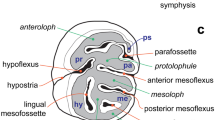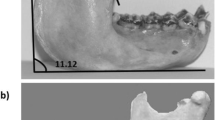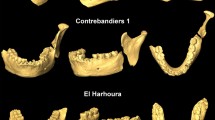Abstract
Although variability of the mandible makes it problematic for taxonomy, the holotypes of three of the oldest European species, Home georgicus, H. antecessor, H. heidelbergensis, are mandibles. Moreover, the distinctive validity of these three species cannot be established from these particular mandibles. The holotype of H. georgicus is pathological and similar to H. erectus in some important features, while others features are so widely spread that they are of little taxonomic value. H. antecessor shows juvenile mandibular features which are chronologically and geographically widespread, and similarities with H. pekinensis do not appear significant. The mandible from Mauer, H. heidelbergensis, is generally plesiomorphic, but similar to Neanderthals in a few important features. Neanderthals are a highly peculiar human group from the anatomical, geographical and chronological points of view. They are genetically different from H. sapiens and they seem to emerge in Europe during Middle Pleistocene. Mauer could be one of their earliest representatives.





Similar content being viewed by others
References
Aguirre E, de Lumley M-A (1977) Fossil man from Atapuerca, Spain: their bearing on human evolution in the Middle Pleistocene. J Hum Evol 6:681–688
Bermúdez de Castro JM, Arsuaga JL, Carbonell E, Rosas A, Martinez I, Mosquera M (1997) A hominid from the Lower Pleistocene of Atapuerca, Spain: possible ancestor to Neanderthals and modern humans. Science 276:1392–1395
Bischoff J, Shamp DD, Aramburu A, Arsuaga JL, Carbonell E, Bermúdez de Castro JM (2003) The Sima de los Huesos hominids date to beyond U/Th equilibrium (>350 kyr) and perhaps to 400–500 kyr: new radiometric dates. J Archaeol Sci 30:275–280
Bräuer G, Schultz M (1996) The morphological affinities of the Plio–Pleistocene mandible from Dmanisi, Georgia. J Hum Evol 30:455–481
Carbonell E, Bermúdez de Castro JM, Arsuaga JL, Allue E, Bastir M, Benito A, Cáceres I, Canals T, Díez JC, van der Made J, Mosquera M, Ollé A, Pérez-González A, Rodríguez J, Rodríguez XP, Rosas A, Rosell J, Sala R, VallverdÚ J, Vergés JM (2005) An Early Pleistocene hominin mandible from Atapuerca-TD6, Spain. Proc Natl Acad Sci USA 102:5674–5678
Creed-Miles M, Rosas A, Kruszynski R (1996) Issues in the identification of Neanderthal derivative traits at early post-natal stages. J Hum Evol 30:147–153
Czarnetzki A, Jakob T, Pusch CM (2003) Palaeopathological and variant conditions of the Homo heidelbergensis type specimen (Mauer, Germany). J Hum Evol 44:479–495
Dean D, Delson E (1995) Homo at the gates of Europe. Nature 373:472–473
Dean D, Hublin JJ, Holloway R, Ziegler R (1998) On the phylogenetic position of the pre-Neanderthal specimen from Reilingen, Germany. J Hum Evol 34:485–508
Eggen S (1992) Correlated characteristics of the jaws: association between torus mandibularis and marginal alveolar bone height. Acta Odontol Scand 50:1–6
Eggen S, Natvig B (1986) Relationship between torus mandibularis and number of present teeth. Scand J Dent Res 94(3):233–240
Falgueres C, Bahain J-J, Yokoyama Y, Arsuaga JL, Bermúdez de Castro JM, Carbonell E, Bischoff JL, Dolo J-M (1999) Earliest humans in Europe: the age of TD6 Gran Dolina, Atapuerca, Spain. J Hum Evol 37:343–352
Franciscus RG, Trinkaus E (1995) Determinants of retromolar space presence in Pleistocene Homo mandibles. J Hum Evol 28:577–595
Gabunia L, de Lumley M-A, Vekua A, Lordkipanidze D, de Lumley H (2002) Découverte d’un nouvel hominidé à Dmanissi (Transcaucasie, Géorgie). C R Palevol 1:243–253
Gabunia L, Vekua A (1995) A Plio–Pleistocene hominid from Dmanisi, East Georgia, Caucasus. Nature 373:509–512
Gabunia L, Vekua A, Lordkipanidze D, Swisher III CC, Ferring R, Justus A, Nioradze M, Tvalchrelidze M, Anton SC, Bosinski G, Joris O, de Lumley M-A, Majsuradze G, Mouskhelishvili A (2000) Earliest Pleistocene hominid cranial remains from Dmanisi, Republic of Georgia: taxonomy, geological setting, and age. Science 288:1019–1025
Haugen LK (1992) Palatine and mandibular tori. A morphologic study in the current Norwegian population. Acta Odontol Scand 50:65–77
Hublin JJ (1998) Climatic changes, paleogeography, and the evolution of the Neanderthals. In: Akazawa T Aoki K, Bar-Yosef O (eds) Neanderthals and Modern Humans in Western Asia. Plenum Press, New York pp 295–322
Kaifu Y, Aziz F, Baba H (2005) Hominid mandibular remains from Sangiran: 1952–1986 Collection. Am J Phys Anthropol 128:497–519
Kaifu Y, Baba H, Aziz F, Indriati E, Schrenk F, Jacob T (2005) Taxonomic affinities and evolutionary history of the early Pleistocene hominids of Java: dentognathic evidence. Am J Phys Anthropol, Published On-line: 10 Mar 2005
King W (1864) The reputed fossil man of the Neanderthal. Q J Sci 1:88–97
Krings M, Stone A, Schmitz RW, Krainitzki H, Stoneking M, Pääbo S (1997) Neanderthal DNA sequences and the origin of modern humans. Cell 90:19–30
Krings M, Geisert H, Schmitz RW, Krainitzki H, Pääbo S (1999) DNA sequence of the mitochondrial hypervariable region II from the Neanderthal type specimen. Proc Natl Acad Sci USA 96:5581–5585
Lee S-H (2005) Brief communication: is variation in the cranial capacity of the Dmanisi sample too high to be from a single species? Am J Phys Anthropol 127:263–266
Lordkipanidze D, Vekua A, Ferring R, Rightmire GP, Agusti J, Kiladze G, Mouskhelishvili A, Nioradze M, Ponce de Leon MS, Tappen M, Zollikofer CPE (2005) Anthropology: the earliest toothless hominin skull. Nature 434:717–718
Mallegni F, Carnieri E, Bisconti M, Tartarelli G, Ricci S, Segre A (2003) Homo cepranensis sp. nova and the evolution of African–European Middle Pleistocene hominids. C R Palevol 2:153–159
Ovchinnikov IV, Gotherstrom A, Romanova GP, Kharitonov VM, Liden K, Goodwin W (2000) Molecular analysis of Neanderthal DNA from the northern Caucasus. Nature 404:490–493
Parés JM, Pérez-Gonzàlez A (1995) Paleomagnetic age for hominid fossils at Atapuerca archaeological site, Spain. Science 269:830–832
Quam RM, Arsuaga J-L, Bermúdez de Castro J-M, Diez JC, Lorenzo C, Carretero JM, Garcia N, Ortega AI (2001) Human remains from Valdegoba Cave (Huérmeces, Burgos, Spain). 41:385–435
Rak Y, Kimbel WH, Hovers E (1994) A Neanderthal infant from Amud cave, Israel. J Hum Evol 26:313–324
Rightmire GP (1985) The tempo of change in the evolution of mid-Pleistocene Homo. In: Delson E (ed.) Ancestors: The Hard Evidence. A.R. Liss, New York, pp 255–264
Rightmire GP (1990) The evolution of Homo erectus. Comparative Anatomical Studies of an Extinct Human Species. Cambridge University Press, Cambridge
Rightmire GP (1998) Human evolution in the Middle Pleistocene: the role of Homo heidelbergensis. Evol Anthropol 6:218–227
Rosas A (2001) Occurence of Neanderthal features in mandibles from the Atapuerca-SH site. Am J Phys Anthropol 114:74–91
Rosas A (1995) Seventeen new mandibular specimens from the Atapuerca/Ibeas Middle Pleistocene hominids sample. J Hum Evol 28:533–559
Rosas A, Bermúdez de Castro JM (1998a) On the taxonomic affinities of the Dmanisi mandible (Georgia). Am J Phys Anthropol 107:145–162
Rosas A, Bermùdez de Castro JM (1998b) The Mauer mandible and the evolutionary significance of Homo heidelbergensis. Geobios 31:687–697
Rosas A, Bermúdez de Castro JM (1999) The ATD6-5 mandibular specimen from Gran Dolina (Atapuerca, Spain). Morphological study and phylogenetic implications. J Hum Evol 37:567–590
Schoetensack O (1908) Der unterkiefer des Homo heidelbergensis aus den sanden von Mauer bei Heidelberg. Leipzig, W. Engelmann
Schwartz JH (2004) Anthropology. Getting to know Homo erectus. Science 305:53–54, Comment on: Science, 2004, Jul 2305(5680):75–78
Schwartz JH, Tattersall I (2002) The Human Fossil Record, volume 2: Craniodental Morphology of Genus Homo (Africa and Asia). Wiley-Liss, New York
Seah YH (1995) Torus palatinus and torus mandibularis: a review of the literature. Aust Dent J 40(5):318–321
Simpson GG (1961) Principles of Animal Taxonomy. Columbia University Press, New York
Skinner MM, Gordon AD, Collard NJ (2006) Mandibular size and shape variation in the hominins at Dmanisi, Republic of Georgia. J Hum Evol 51:36–49
Stringer CB, Hublin J-J, Vandermeersch B (1984) Western Europe. In: Smith FH, Spencer F (eds), The Origins of Modern Humans. A World Survey of the Fossil Evidence. A.R. Liss, New York, pp 51–135
Tattersall I (1986) Species recognition in human paleontology. J Hum Evol 15:165–175
Trinkaus E (1993) Variability in the position of the mandibular dental foramen and the identification of Neanderthal apomorphies. Riv Antropol 71:274–295.
Vekua A, Lordkipanidze D, Rightmire GP, Agusti J, Ferring R, Maisuradze G, Mouskhelishvili A, Nioradze M, Ponce de Leon M, Tappen M, Tvalchrelidze M, Zollikofer C (2002) A new skull of early Homo from Dmanisi, Georgia. Science 297:85–89
Weidenreich F (1936) The mandible of Sinanthropus pekinensis: a comparative study. Paleontol Sin New Ser D, 7(f4):1–162
Weidenreich F (1945) Giant early man from Java and south China. Anthropological Papers of the American Museum of Natural History, New York
Wiley EO (1978) The evolutionary species concept reconsidered. Syst Zool 27:17–26
Wolpoff MH, Frayer DW (2005) Unique ramus anatomy for Neanderthals? Am J Phys Anthropol 128:245–251
Wood BA (1991) Koobi Fora research project. Vol.4. Hominid cranial remains. Clarendon Press, Oxford
Wood BA, Van Noten FL (1986) Preliminary observations on the BK 8518 mandible from Baringo, Kenya. Am J Phys Anthropol 69:117–127
Author information
Authors and Affiliations
Corresponding author
Rights and permissions
About this article
Cite this article
Fabbri, P.F. Mandible and Taxonomy of the Earliest European Homo . Human Evolution 21, 289–300 (2006). https://doi.org/10.1007/s11598-006-9028-3
Received:
Accepted:
Published:
Issue Date:
DOI: https://doi.org/10.1007/s11598-006-9028-3




